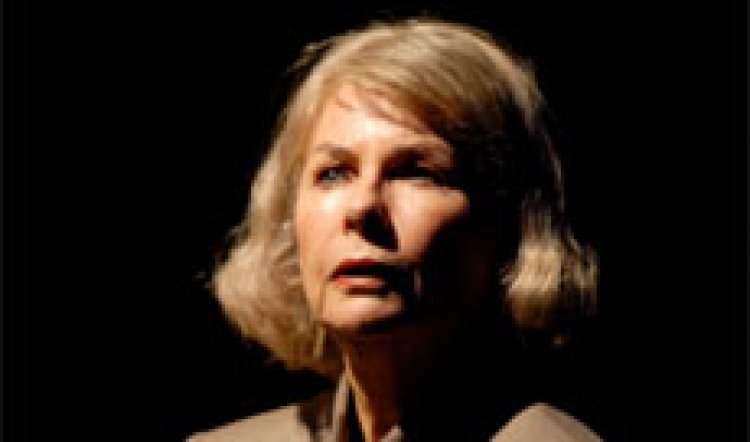
Year of Magical Thinking
The Year of Magical Thinking, Wharf 1, from March 29, 2008; ph: +62 2 9250 1777 www.sydneytheatre.com.au; touring to Parramatta Riverside, May 28-31; Glen Street Theatre, Belrose June 4-15; Illawarra Performing Arts Centre, Wollongong June 18-21; Canberra Theatre Centre, Canberra July 2-5; Civic Theatre, Newcastle July 16-19. Tickets may be purchased directly through venues.
How to tell the untellable? How to bear the unbearable? How to explain the inexplicable? Those questions are among the impulses behind Joan Didion’s unique memoir The Year of Magical Thinking. It is a forensic examination of her experience of the sudden death late in 2003 of her husband of close to 40 years, John Gregory Dunne, and is distilled essence of Didion.
Candid, clear-eyed, analytical, seemingly effortlessly stylish and witty, Didion on death is merciless in the face of a culture of avoidance and sentimentality. The book is compelling and elegant, its honesty in looking at the madness of grief and bereavement is, quite literally, breathtaking. How then to transform such a literary feat into a work for the stage?
And how to even think about such a thing when, soon after completing the book, she was then faced with the death of their 38-year-old daughter Quintana in the northern summer of 2005? This last terrible event now forms the coda to the one-woman play Didion herself fashioned from the book.
It’s hard to imagine anyone (such as original producer Scott Rudin) being tough enough or inspired enough to ask the author to do it, except of course, it makes so much sense and, now it’s done, an inevitability. The Year of Magical Thinking is a natural for live performance in its immediacy, intimacy and – quite frankly – marvelously terrible narrative.
The play, starring Robyn Nevin as Didion, opens with a pronouncement in well-modulated East Coast American tones that send a chilly shock up the collective spines of the audience: “This happened on December 30, 2003. That may seem a while ago, but it won’t when it happens to you. And it will happen to you.”
It's the kind of line Nevin might have been born to deliver: crisp, with a hint of threat yet also suggesting underlying humour, pathos and the possibility of fragility. It is alarming. The 90-odd minutes that follow are absorbing as Nevin-Didion tells the story of one woman’s response not only to sudden death but to what happens to her, psychically, physically and emotionally in the months that follow.
Magical thinking, we learn, is the logical illogic of belief over reality. When her husband is officially pronounced dead at New York–Presbyterian Hospital, Didion– the super-journalist and chronicler of her times – has already gathered the hints and facts to know this. She knows, for instance (and drolly says so) that to be assigned a social worker at such a time is seriously bad news. When the doctor asks if she will be able to get home? does she have someone to come stay with her? the social worker says of the newly-created widow: "It's okay. She's a pretty cool customer."
This goes into the notebook to be re-examined at a later date and then to be joined by the observation, to the audience, that she did not want company, not because she was cool and could cope but because, "I needed to be alone so that he could come back."

Later on she notes all the things she has to do post-death, post-funeral, such as bag up clothes to send away, but she cannot part with his shoes – because he will need them when he returns. And this despite having authorised an autopsy and read the reports. She knew exactly what had happened to her husband when he slumped over the dinner table in their apartment and turned out not to have been playing a prank on her after all. But it didn’t stop her doing whatever was necessary for him to return.
Possibly the most moving aspect of this extraordinary work is the comedy. Didion is an acerbic commentator and spares no one, least of all herself. There is much laughter and wit to savour. It is this leavening and the shading in Nevin’s performance that makes The Year of Magical Thinking so effective and fascinating. As directed by Cate Blanchett, the storyteller is on an endless, restless prowl through her memories and thoughts and among rows of chairs that fill the stage, suggesting a waiting room, a church or even a theatre.
This set design, by Alice Babbidge, lit by Nick Schlieper in powerful stabs of white light, lends itself to movement. It suggests an element of naturalism as Nevin moves from chair to chair, place to place, speaking directly to the audience. It effectively diffuses the immediate tension and theatricality and so enables the playing of it to lay bare the sum and substance of what Didion has accomplished in the work.
Composer and sound designer Natasha Anderson adds scenic punctuation that sounds like the rhythmic hiss of high-tech medical equipment, blood rushing in veins, the wind, the ocean (a recurring theme for Didion, a one-time Malibu resident), neuro-surgery, oxygen tubes. Life … and death. And all the while, Nevin/Didion tracks the truth, the facts, the causes and contributors to her situation.
It is as intensely personal as could be imagined, but – going back to the opening line of the piece – it is universal too. It may not happen with such brutality and so painfully publicly, but something of what Didion experienced and so beautifully and unflinchingly describes certainly will. The Year of Magical Thinking is not so much a play as a testament to the power of laughter, intelligence, courage and love. As such it is one of the most uplifting and, dare I say it, entertaining 90 minutes of Life ever seen on a Sydney stage.



